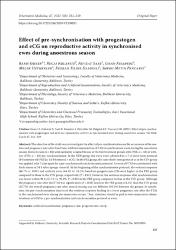Effect of pre-synchronisation with progestogen and ecg on reproductive activity in synchronised ewes during anoestrous season

Göster/
Erişim
info:eu-repo/semantics/openAccessTarih
2022Yazar
Güner, BarışKulaksız, Recai
Saat, Nevzat
Kısadere, İhsan
Öztürkler, Melek
Dalgınlı, Kezban Yıldız
Pancarcı, Şükrü Metin
Üst veri
Tüm öğe kaydını gösterÖzet
The objective of the study was to investigate the effect of pre-synchronisation on the occurrence of the oestrus and pregnancy rate after fixed time artificial insemination (FTAI) in synchronised ewes during the anoestrous season. Kivircik ewes (n = 84) were randomly assigned to one of the two treatment groups with (PRE; n = 42) or without (SYN; n = 42) pre-synchronisation. In the SYN group, the ewes were subjected to a 7-d short-term protocol (P4 insertion-6d-PGF2 alpha-1d-P4 removal + eCG). In the PRE group, the same short-term protocol as in the SYN group was applied with 7 days apart for a pre-synchronised synchronisation protocol. A cervical FTAI was performed with fresh semen at 54 h after sponge removal. At the beginning of the synchronisation protocol, the oestrous response (66.7% vs. 0.0%) and cyclicity rates (64.3% vs. 14.3%) based on progesterone (P4) were higher in the PRE group compared to those in the SYN group, respectively (P < 0.01). However, the oestrous response after synchronisation was lower within 96 h (57.1% vs. 95.2%; P < 0.01) in the PRE group compared to that in the SYN group. Although the pregnancy rate after the FTAI was significantly (P < 0.05) lower in the PRE group (14.3%) than the SYN group (35.7%), the overall pregnancy rate after natural mating was not different (95.2%) between the groups. In conclusion, the pre-synchronisation decreased the oestrous response leading to a lower pregnancy rate after the FTAI in the synchronised ewes during the anoestrous season. Thus, attention should be paid to two consecutive administrations of eCG in a pre-synchronisation and synchronisation protocol in ewes.

















